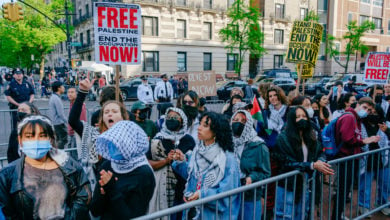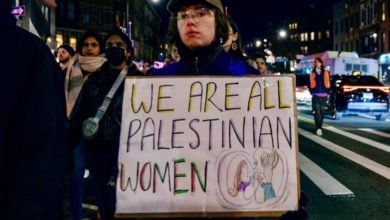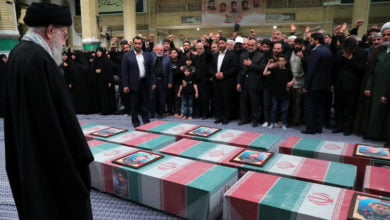Photo: IDF soldiers with a journalist. Credit: Flick/IDF (CC BY-NC 2.0 DEED)
Israel is in a strategic bind. Over the last weeks a wave of defeatist, pro-Israel articles flooded the media in Israel and the United States. Lead among them, Israeli newspaper Haaretz published a piece with a blunt headline: “Saying What Can’t Be Said: Israel Has Been Defeated – a Total Defeat.” To casual observers of Israeli atrocities — and to many Zionists around the world — the idea that one of the most well-equipped, so-called advanced militaries in the world could be resoundingly, even totally, defeated is a shocking proposition.
The capacity of the Palestinian factions in Gaza to resist remains intact, in spite of the Israeli aim of “dismantling Hamas”. The prisoners taken on Oct. 7 have only been released through negotiations. Hundreds of thousands of settlers have fled from the settlements inside the Gaza envelope and along the Lebanese border, many without plans to return. Iran’s intervention revealed the weaknesses in Israel’s air defense systems and reliance on the United States and U.S.-backed Arab regimes to intercept the Iranian attack.
The political and social crises within Israel are sharper than ever and the balance of forces regionally is not in their favor, as covered recently in Liberation News. How did we get to this point? How has the resistance achieved their war aims? What has been the Israeli strategy in pursuing this genocide? And what can historical precedents tell us about what might come next?
Three legs of Zionist hard power
From its earliest days in the late 19th century, Zionist hard power in Palestine has been constructed on three key pillars: technological, financial, and military supremacy through alliance with Western imperialism, militarized settlements that blur the line between civilian and soldier, and a reliance on terrorism to maintain a psychological aura of omnipotence.
Technological military supremacy has been a cornerstone of Israeli military strategy and self-concept from the earliest days, and confidence in this strategy was bolstered multiple times by the defeats of large scale, conventional Arab armies at the hands of the Zionists throughout the 20th century. However, since Hezbollah, the Lebanese resistance group and guerilla army, defeated Israel in 2006, Israeli forces have refused to learn important lessons from this engagement, focusing instead on two primary tactics: bombing Gaza from the air and “policing” the occupied and largely demilitarized Palestinian populace in the West Bank.
Similarly, since the first kibbutz, the dual civilian-military purpose of settlements has been integral to Zionist military construction and social reproduction. Like the border towns that dot the outskirts of Native reservations across the United States and along the length of the Mexican border, Israeli kibbutzim in Palestine follow the same military logic of settler colonial expansionism. In Israel, it is a step more explicit. These settlements are not simply home to soldiers — for example the Gaza envelope settlements of kibbutzim Be’eri, Re’im, and Nahal Oz all also have accompanying military bases of the same name.
Finally, terrorism designed to make Palestinians abandon their land has been integral to Israeli military strategy from the bombings and massacres that defined the British Mandate era and repeated ad nauseam from Deir Yassin to Kfar Qassem to the Suez Crisis to Sabra and Shatilla to the Ibrahimi Mosque to Jenin to the Mavi Marmara to Al-Shifa Hospital. The aim of terrorism as such is to cultivate, on one hand, a deeply rooted mindset of defeatism in the Palestinian nation, and on the other, to reproduce Israelis’ own sense of supremacy.
Each one of these strategic pillars was undermined by events on Oct. 7 have been continually proven to be ineffective, outdated, and impotent against the Palestinian and regional resistance.
Oct. 7: A ‘Mass Hannibal Event’
On the morning of Oct. 7, fighters from Hamas’s armed wing, the Qassam Brigades, broke through the fence along the Gaza border. Under the cover of a barrage of several thousand rockets, the brigade headed toward the headquarters of Israel’s Gaza Division and Southern Command. The goal was to attack military targets and take military captives to exchange for the thousands of Palestinian prisoners held in Zionist prisons, as well as put the question of Palestine back on the international table in a real way as more and more reactionary Arab governments turned toward normalization with Israel in recent years.
The Qassam fighters found their enemy unprepared and in disarray. The headquarters of the Gaza division was seized in under an hour and Israeli command and control broke down completely. Units that were active in the area were without orders and no top level command was issued for hours, much less able to make it down the chain to soldiers on the ground. This chaos reigned for hours, with Israeli units operating without coordination and essentially firing at anything that moved within the Gaza envelope, including one another.
One story involved all-women armored units from the Paran Brigade roving the countryside for 16 hours without orders, reported in Israeli media as a win for feminism as these women killed “over 50 terrorists.” A more rational reading of this story, that several low level soldiers (all in their early 20’s) were abandoned by command and left to roam the countryside killing indiscriminately for 16 hours straight, paints a much different portrait of the capacity of the Zionist forces.
But these “friendly fire” instances cannot be explained just simply by the chaos that resulted in getting caught unprepared. The Hannibal Directive is a military policy that requires the use of maximum force in the event that a soldier is being kidnapped. “You will open fire without constraints, in order to prevent the abduction,” says a former IDF soldier quoted in Al Jazeera. He added that such force is applied even at the risk of killing a captive soldier.
This calculation is based on the reality that letting resistance forces take Israeli prisoners is of greater strategic damage to Israel than the deaths of Israelis and has been publicly known for years. What is new and shocking about Oct. 7 is that it has been confirmed by multiple Israeli sources that Israeli command issued a mass Hannibal Directive with regard to all prisoners taken — including alleged civilians. The widely circulated images of burnt out cars from the Nova Music Festival and houses completely destroyed could only have been achieved by high powered incendiary shells used by Israeli tanks and helicopters. Given the already described breakdown of command and control on the Israeli side, the use of Hannibal unleashed an unprecedented level of violence that killed hundreds of Israelis.
The fear of letting their soldiers be captured is not irrational on the part of the Israeli military. In 2011, current Hamas leader Yahya Sinwar was released in part of a deal that saw 1,027 Palestinians freed for the return of one Israeli soldier held by Hamas, Gilad Shalit. This seemingly disproportionate exchange is an integral part of the previously ruling logic of Zionist settler colonialism. With mandatory conscription, the vast density of para-state settler militias, and within the colonial relationship more broadly, the distinction between civilian and military personnel is blurred.
From this perspective, disparity in numbers seen in the Shalit deal is a core part of the psychological contract signed between the Israel and the settler population. The spirit of the Hannibal Directive has continued to play out in how the Zionist forces have approached the issue of returning the prisoners currently held by the Palestinian Resistance — unable or unwilling to launch ground operations to enter the tunnels and retrieve them, Israeli forces seem content to kill their own people alongside every other person in Gaza.
The reaction within Israeli society to the mass Hannibal revelations and the handling of the hostages demonstrates the degree to which these events are seen as a betrayal by the settler populace. The breakdown of the social contract is in no small part contributing to the flood of settlers leaving Occupied Palestine. Ronen Bergman, a senior political analyst for the Israeli newspaper Yedioth Ahronoth, was recently quoted in the Hebrew media (translated by Al Mayadeen here) saying with regard to the recent meetings of the Israeli War Cabinet discussing potential responses to Iran’s retaliation: “If they had filmed it and broadcast it on YouTube, today there would be four million people in Israel trying to find a way to escape from here.”
The Dahiya Doctrine and the Gospel
The Dahiya Doctrine gets its name from the Dahiya neighborhood in Beirut which Israel identified as a “Hezbollah stronghold” during the 2006 invasion of Lebanon. The Israelis subjected the neighborhood to scorched earth tactics that have become familiar scenes from Gaza in every Israeli offensive against Gaza since 2008. In a report by a UN fact-finding mission in the aftermath of Israel’s 2008-2009 war on Gaza, Deputy Prime Minister Eli Yishai is quoted on Jan. 6, 2009: “It [should be] possible to destroy Gaza, so they will understand not to mess with us. It is a great opportunity to demolish thousands of houses of all the terrorists, so they will think twice before they launch rockets.”
This crude admission gets at the heart of the Dahiya Doctrine — strategically, it is meant to increase Israeli deterrence. In military theory, deterrence is the credible threat of force used to prevent another actor from taking hostile action. Israeli deterrence has always relied on the threat of swift, overwhelming force provided by its technological edge, whether to commit massacres during the Nakba or rout the Arab armies in 1967 and 1973. In many ways, this is not a novel strategic development on the part of Israel. Terrorism has been a cornerstone of colonial and imperialist violence for hundreds of years.
The “shock and awe” of the 2003 U.S. invasion of Iraq, which targeted civilian infrastructure with mass destruction, represents another manifestation of this colonial strategy in the 21st century. Further back, a similar approach was applied by U.S. imperialists in the mass carpet bombing of Korea. It is in the relentless Israeli campaigns against Gaza over the last two decades that the Dahiya Doctrine has been refined into a precise, automated killing machine. The Israeli military revealed last year that it has been developing and utilizing an AI-powered target generation system known as Hasbora, or the “the Gospel” in Hebrew.
Hasbora codifies, automates, and expands what has been true in every previous Israeli assault on Gaza. In a report published in +972 Magazine, the system is described as being able to “‘generate’ targets almost automatically at a rate that far exceeds what was previously possible,” and as a “mass assassination factory.” “Mass assassination” here is the appropriate term — there is nothing indiscriminate about the bombings carried out daily by Zionist forces. Over half of the targets generated by Hasbora in the course of the fighting have been what are called “power targets,” which includes “private residences as well as public buildings, infrastructure, and high-rise blocks.” These targets are disgusted to cause the biggest shock possible to the social fabric of Gaza.
Similar to many of the applications of the suite of technologies popularly known as “artificial intelligence,” this cutting edge technology has only served to amplify and intensify the existing strategic equation on the Israeli side. The ability of Israeli forces to leverage technological and financial dominance into credible deterrence has collapsed. The threat of the Dahiya Doctrine did not deter the Palestinian Resistance from launching Al-Aqsa Flood last year, nor Seif al-Quds in 2021. It has not deterred the Lebanese resistance from supporting Palestinians on the northern front. Despite ten years of Dahiya-style bombardment in the U.S.-backed Saudi war on Yemen, the Yemeni resistance is undeterred.
Al-Aqsa Flood, deterrence, and continuing the resistance
Over the decades the Palestinian struggle has seen many setbacks. The anti-imperialist struggle in the region has seen many, many setbacks. At a bare minimum, 5 million people from Sudan to Afghanistan have been directly killed between the invasions, dirty wars, coups, and interventions led by the United States just in the last 30 years and the number is undoubtedly much, much higher in reality. The United States has had its forces and operatives on the ground in the region for so long that it has not had to rely on Israel as an independent actor the way it did in the mid to late 20th century.
This same period was an era defined by the Oslo Accords, the so-called “peace process,” and continual degradation and encroachment of Palestinian life in the occupied West Bank and Gaza. The Palestinian liberation movement was fractured, divided, and lost many of its material sponsors with the collapse of the socialist camp and the anti-colonial movements. In its place rose the comprador regime of the Palestinian Authority and a retreat of militant forces. This was a period of great difficulty for the national liberation movement and the global anti-imperialist movement.
The Israelis were content, meanwhile, to continue the slow and steady process of ethnic cleansing and apartheid, self-assured in their own omnipotence and the weakness of the Palestinian movement. They did not learn any lessons from their defeat in Lebanon in 2006, instead employing a nearly identical strategy against Gaza half a dozen times in two decades. Oct. 7 and the nearly 200 days since then have revealed these suppositions about the balance of forces to be a house of cards.
The resistance regionally has also demonstrated an incredibly high level of strategic patience and tactical skill. The networks that formed the basis for the Axis of Resistance go back to the 1980s during the Israeli occupation of southern Lebanon. A new generation of organizations rose up to combat this occupation, including elements that would become Hezbollah. Since their victory in 2006, Hezbollah has developed, with assistance from Iran, a complex, indigenously produced missile stockpile and deep underground fortifications.
Similarly, the resistance in Gaza have — even under the conditions of siege — built a similarly complex indigenous weapons production capacity and the much discussed tunnels under Gaza. This has made Israeli ground operations within Gaza over the last months catastrophic. In countless videos released by the resistance, as well as in statements from the Israeli military, it is clear that large numbers of officers have been killed by the resistance requiring constantly calling up reservists, that tank units travel without infantry escorts making them vulnerable to ambushes, and that ultimately, the Israeli military as a fighting force on the ground cannot match the organization, leadership, bravery, and audacity of the Palestinian resistance.
The resistance factions also retain a high level of popular support across Palestinian society. The unity of different political and sectarian factions on the military front has prompted discussions between the leaders of the factions in Beirut and Moscow in recent months about potential day-after plans, on Palestinian terms. Whether a national unity government that includes all the factions, a revitalized PLO, or something else entirely, the Palestinian resistance has reignited a vision of a Palestinian future.
Additionally, exemplified by the unprecedented Al-Quds Day press conference which featured speeches from leaders across the Resistance Axis and the strategic coordination of the Gaza, Lebanon, and Yemen fronts as well as actions from Iraq and Iran, the Palestinian struggle is pulling the region closer toward cooperation and integration than potentially any time since the short-lived heyday of Pan-Arabism in the 1950s and 60s or the Arab nationalist revolts in the final days of the Ottoman Empire.
What options does Israel have?
Israel aimed and failed to reestablish their deterrence capacity after being humiliated by Hamas on Oct. 7. It is in fact the Axis of Resistance which has succeeded in establishing credible deterrence — on the ground in Gaza and Lebanon, in the seas off Yemen, and with Iranian missiles and drones striking their targets within Israel. The United State is effectively deterred from further escalation and, despite Israeli bluster, it seems unlikely to pursue a regional war.
Despite deploying massive violence, the strategic calculus of the Israeli military has remained stagnant and disjointed. Israeli society is riven with division and fear. The IDF image of omnipotence has been shattered. A regional war against the full force of the resistance would be disastrous for the peoples of the region and ultimately suicidal for the Zionist project, but there are very few power centers or individuals in Israeli politics who seem ready to admit defeat and make serious concessions at the negotiating table.
Israel is backed into a corner with no good options. It is also moments like this that the most unhinged and self destructive tendencies in a society become viable. It is impossible to predict what will happen next, but what is abundantly clear is that the previously hegemonic logics of escalation, deterrence, and what is possible in this struggle have been upended.






